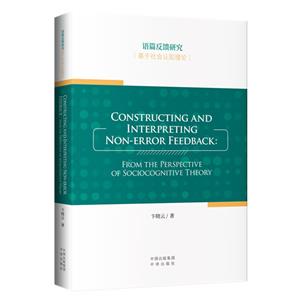-
>
考研英語背單詞20個詞根詞綴
-
>
西班牙語詞根寶典
-
>
美國K-12原版語文課本--初中·下(全12冊)
-
>
流浪地球劉慈欣
-
>
西南聯大英文課 輕讀禮盒版
-
>
英語大書蟲世界經典名譯典藏書系:中國人的精神 (英漢對照)(精選權威版本)
-
>
許淵沖譯唐詩三百首:漢文·英語
語篇反饋研究:基于社會認知理論 版權信息
- ISBN:9787500172468
- 條形碼:9787500172468 ; 978-7-5001-7246-8
- 裝幀:一般膠版紙
- 冊數:暫無
- 重量:暫無
- 所屬分類:>>
語篇反饋研究:基于社會認知理論 本書特色
《語篇反饋研究:基于社會認知理論》這本書將提供中國英語寫作教學環境視角,充實二語寫作教師非糾錯性的語篇反饋方面的研究。 《語篇反饋研究:基于社會認知理論》這本書有其獨到的實際應用價值。隨著時代的發展,盡管智能/自動反饋系統已經取得了很大的進步,但該系統主要提供的反饋還是為和語言有關的糾錯性反饋,怎樣能更好地提供非糾錯性的語篇反饋還是該系統升級改造的一大方向。本書所探討的教師如何提供非糾錯性語篇反饋、學生如何解讀加工非糾錯性語篇反饋將為人工智能系統的改進和完善提供思路。
語篇反饋研究:基于社會認知理論 內容簡介
《語篇反饋研究:基于社會認知理論》這本書詳述了一項關于中國外語教師語篇反饋的歷史個案研究, 揭示出在中國外語教學環境下針對大學生的英語說明文,教師構建語篇反饋、學生加工語篇反饋時,他們的決策過程(decision-making)符合社會認知理論所提出的"身心世界"一體原則。在反饋過程中,教師、學生、情景之間的復雜動態交互也有助于學生作為寫作者和反饋接收者在認知、情感、行為等方面實現發展。
語篇反饋研究:基于社會認知理論 目錄
Table of Contents
List of Tables .......................... Ⅰ
List of Abbreviations...................... Ⅲ
Chapter 1 Introduction ..................... 1
1.0 Introduction: An Overview ................. 1
1.1 Problem Statement .................... 2
1.2 The Rationales Behind the Study ............... 6
1.3 Overview of Research Methodology ............ 12
1.4 Significance of the Study ................. 13
1.5 Organization of the Book ................. 15
Chapter 2 Issues in Teacher Feedback.............. 16
2.0 Introduction ...................... 16
2.1 Development of Teacher Feedback: Questions......... 16
2.2 Theoretical Perspectives on Teacher Feedback and Its Importance . 23
2.3 Research on Teacher Feedback............... 44
2.4 Research Gaps and Emergent Issues............. 68
2.5 Chapter Summary .................... 72
Chapter 3 Research Design .................. 73
3.0 Introduction ...................... 73
3.1 Research Design: The Rationale .............. 73
3.2 Research Design: Defining the Term “Case Study” ....... 74
3.3 Research Design: Key Issues ............... 80
3.4 Chapter Summary .................... 116
Chapter 4 The Construction of Non-error Feedback........ 117
4.0 Introduction ...................... 117
4.1 What the Teacher Brought to the Feedback Process: Contextual
Information ...................... 118
4.2 The Entire Feedback-Constructing Process the Teacher Went Through:
Contextual Information.................. 129
4.3 The EA Issues the Teacher Actually Focused on ........ 129
4.4 Teacher Decision-Making: How the Teacher Decided Which EA
Issues to Focus on.................... 133
4.5 The Feedback Delivery Approaches the Teacher Used ..... 136
4.6 Teacher Decision-Making: How the Teacher Decided on Feedback
Delivery Approaches................... 144
4.7 Chapter Summary .................... 164
Chapter 5 The Interpretation of Non-error Feedback ....... 168
5.0 Introduction ...................... 168
5.1 What the Students Brought to the Feedback Process: Contextual
Information ...................... 169
5.2 Student A’s Acceptance and Incorporation of EA Feedback.... 177
5.3 Student B’s Acceptance and Incorporation of EA Feedback ... 184
5.4 Student C’s Acceptance and Incorporation of EA Feedback ... 190
5.5 How the Students’ Acceptance and Incorporation of EA Feedback
were Decided...................... 194
5.6 Chapter Summary .................... 223
Chapter 6 The Feedback Process: Its Effectiveness and Helpfulness . 227
6.0 Introduction ...................... 227
6.1 Effectiveness of the Feedback Process ............ 227
6.2 Helpfulness of the Feedback Process: Student Changes ..... 234
6.3 More Helpfulness of Non-error Feedback .......... 235
6.4 Chapter Summary .................... 242
6.5 Summary of All Findings ................. 243
Chapter 7 Discussion and Conclusion .............. 245
7.0 Introduction ...................... 245
7.1 Aims and Methodology of the Study ............ 245
7.2 Summary of Key Findings ................ 246
7.3 Contributions of the Findings ............... 249
7.4 Limitations and Future/Further Research ........... 302
7.5 Final Remarks ..................... 306
References .......................... 308
Appendices.......................... 334
Appendix A: Teacher Background Interview Guide ......... 334
Appendix B: Student Background Interview Guide ......... 336
Appendix C: Think-Aloud Protocol in the Training Session...... 338
Appendix D: Teacher Retrospective and Ongoing Interviews Guide .. 340
Appendix E: Student Retrospective and Ongoing Interviews Guide .. 342
V
Appendix F: Teacher/Student Final Interview Guide ........ 344
Appendix G: Teacher Think-Aloud Data Codebook ......... 346
Appendix H: Student Think-Aloud Data Codebook ......... 350
Appendix I: Student Writing with Teacher Comments ........ 357
Appendix J: Student Writing with Teacher Comments and Student-Written
Notes ......................... 360
Appendix K: Writing Prompts ................. 364
語篇反饋研究:基于社會認知理論 節選
Teacher written feedback on second language (L2) students’writing (hereinafter mainly referred to as “teacher feedback” for short) has been a subject of researchers’interest since the 1980s (Bitchener & Ferris, 2012; Ferris, 2003). However, research into it has mainly focused on the surface level errors of student writing and there has only been a small body of research addressing teacher feedback on non-error issues such as the organization and content of student writing (Ferris & Hedgcock, 2014; Goldstein, 2001, 2006, 2016). This book directs its attention to non-error feedback and prioritizes Chinese EFL (English-as-a-Foreign-Language) teachers’ feedback on the argumentation-related issues in expository writing (hereinafter referred to as feedback on “expository argumentation” or “EA feedback” for short, e.g., teacher feedback on supporting evidence). By defining teacher feedback from the sociocognitive perspective and focusing on EA feedback, this book reports a study on the process during which teachers construct EA feedback and students interpret that EA feedback (hereinafter mainly referred to as “the feedback-and-interpretation process” for short). Reporting this study in this book aims to extend the empirical, theoretical, and knowledge base of teacher written feedback. Specifically, the following three research questions (hereinafter referred to as “RQ(s)” for short) were addressed in the study this book reports: ● RQ1: When constructing feedback, how does the Chinese EFL teacher decide what EA concerns to focus on and how to deliver EA feedback? ● RQ2: When processing the teacher’s EA feedback, how does the Chinese EFL student decide the extent to which it is accepted and incorporated? ● RQ3: According to the student and the teacher, to what extent does the process of constructing and interpreting EA feedback help students improve, if it is considered effective? This introductory chapter provides an orientation to the study this book reports. It begins with stating the research problem (1.1). Then, the practical, theoretical, and empirical rationales for the three RQs are explained (1.2.1– 1.2.3). Following the rationales that motivated the RQs is a description of the research methodology (1.3), an explanation of the significance of the study this book reports (1.4), and an outline of the organization of this book and the composition of chapters (1.5)
語篇反饋研究:基于社會認知理論 作者簡介
卞曉云,任教于中央財經大學外國語學院,研究方向為外語寫作教學、教學法、教師認知、教師發展。北京外國語大學文秋芳教授“產出導向法”虛擬專業學習共同體成員,曾參與第八批中國外語教育基金項目。
- >
大紅狗在馬戲團-大紅狗克里弗-助人
- >
企鵝口袋書系列·偉大的思想20:論自然選擇(英漢雙語)
- >
朝聞道
- >
名家帶你讀魯迅:朝花夕拾
- >
我從未如此眷戀人間
- >
新文學天穹兩巨星--魯迅與胡適/紅燭學術叢書(紅燭學術叢書)
- >
月亮虎
- >
人文閱讀與收藏·良友文學叢書:一天的工作
















